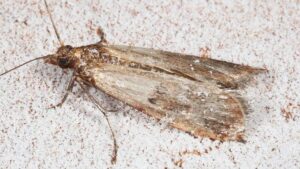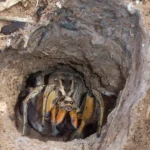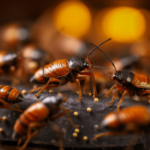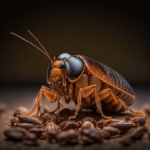
Ultimate Guide on How to Get Rid of Moths As the Peskiest Insects Ever
How do you feel about moths in your closet? And in the pantry? Aren’t you already sick and tired of them? You don’t need to worry so much anymore. We have compiled this comprehensive guide to help you eliminate these nasty insects.
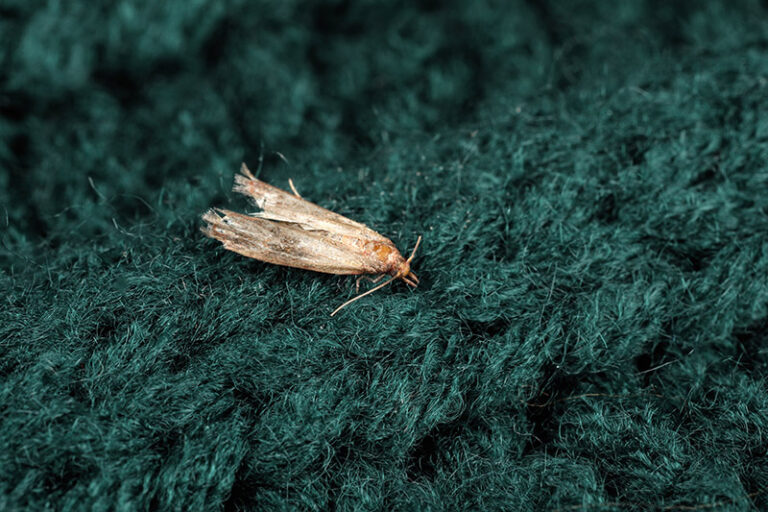
Here, we will tell you everything you want to know about moths. You will learn about their habits and preferences, ways of detecting signs of infestation, and what attracts these guys most in your home. You will get professional tips on preventing moth invasions, dealing with infestations, and getting rid of moths for good.
There are so many types of moths, and it is pretty difficult to identify them all. What you are bothered with now is only one species – the house moth, with its household location varieties.
If you are eager to know how to get rid of moths in your home, continue reading this easy-to-follow guide and say goodbye to these pests forever.
What Is a House Moth and Why Is It Dangerous?
If you have ever noticed tiny holes and damage to your clothing items and other household things made of such natural materials as silk, cotton, wool, feathers, or fur, you need to know that these are traces left behind by the house moths. They are nasty insects also known as the webbing clothes moth or the common clothes moth. Their larvae feed on natural fibers, and you may have trouble trying to repair the damage.
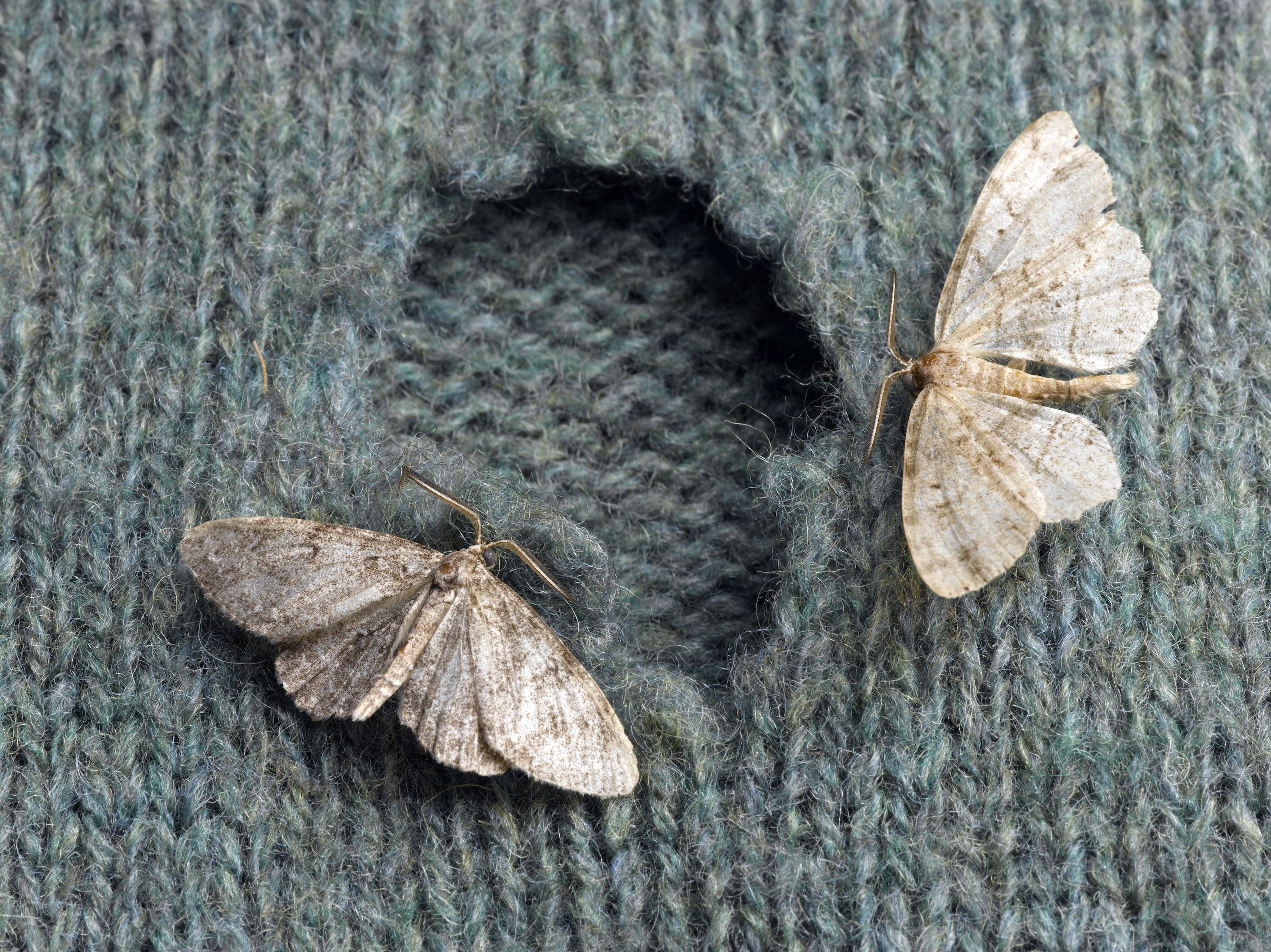
Even if these tiny creatures do not pose any danger to people, the moth infestation is quite an unpleasant thing for your household belongings such as upholstery, overcoats, carpets, etc. The situation may turn out even worth because this infestation is difficult to detect, and you can face unexpectedly extensive damage when you at last discover it. Some people may also experience severe allergies and respiratory problems because of debris left behind by the moth larvae.
Anyway, the situation is not good at all, so you start looking for ideas on how to get rid of moth infestation. Here we are to help you with some professional tips.
What Is the Danger of Having Moths in House or Apartment Areas?
The house moth species are not dangerous for humans at all. However, having them in your household can be a severe problem. Some varieties can invade your kitchen or pantry and cause damage to your food products, especially grains, cereals, or other stored things. Another danger is imposed on carpets, upholstery, clothing, and other natural household items. Infested food can cause digestive problems, while damaged things will need repairs or replacement which can be rather costly.
Therefore, if you have detected some moth eggs, worms, or adult moths in your house or apartment, you should start doing something about it immediately. Or you can prevent the appearance of these unpleasant pests by regular inspections of your food and clothing, keeping your home clean and well-organized, and using adequate pest control methods if they are needed.
Behavior and Habits of Moths
If you want to control the house moth effectively, you need to know more about these insects and their behavior and habits.
Life Cycles of Moths: How Long Do Moths Live?
The moths go over four life cycles in their development. Each of them lasts for several weeks. They are egg, larva, pupa, and adult.
Therefore, moth eggs are the first life cycle. Female moths can lay from only a few to hundreds of eggs near the suitable source of food that has attracted them. Then, the larva cycle follows. It is also known as a caterpillar stage when you can see moth worms on your household items and in the stored foods. This stage can last from a few weeks to some months depending on the species.
The larval period is followed by the pupa stage. The larva spins a cocoon around its body and gradually transforms into an adult moth. This stage lasts the same several weeks or months related to the species’ peculiarities and development conditions. The adult stage is the last one. The adult moth can mate and produce new generations of insects to start the cycle again.
Therefore, the moths usually live for a few weeks to several months in their adult form, and the whole four-cycle pattern lasts for a few months. During that time, an adult female can produce multiple offspring, and the infestation becomes more and more severe.
Habitat Preferences of Moths: Where You Can Find Moth Eggs
Moths can live everywhere – in forests, meadows, deserts, and urban areas, and their habitat preferences depend on species. Nevertheless, moths in house environments prefer living next to natural fibers like silk or wool, or grains and dry foods stored in closets and pantries. They prefer dark and humid areas to lay eggs. It is better for them when the clothing or other items are soiled with sweat or stains because the additional nutrients they contain are beneficial for larvae feeding.
House moths like warm environments, too. The most favorable temperatures for them can range between 10 and 40 degrees Celsius or from 50 to 104 degrees Fahrenheit. Therefore, if you want to prevent infestations, you should air your home regularly, clean it of garbage, and wash clothes as soon as they are stained.
Feeding Habits of Moths
It is important to get rid of moths in the house because they feed on natural fibers and can cause a lot of damage to your clothes, carpets, and other household things. As soon as an egg hatches, a larva starts feeding intensively. It has strong jaws to cut fibers and needs a lot of nutrients to thrive. The most important substance for it is keratin, a kind of protein that can be found in animal fur, skin, and feathers. Larvae can also feed on food debris and dead parts of other insects.
When a larva feeds, it makes fine holes in materials. The fabric is spoiled, and you may need to spend much more to repair or replace your household items. So, your task is to prevent this damage by regular inspections of all your clothes and stored food materials.
Use vacuum-sealed bags or airtight containers to store your things and effective repellents to keep moths away from your home.
Signs of a Clothes Moth Infestation
You also need to know how to detect the infestation and which signs of clothes moth to pay attention to.
Clothes House Moths Identification
There are four things you can notice to suspect that your sweet home is moth-infested. They are the following:
- adult moths;
- larvae;
- damaged items;
- shed skins.
It may be problematic to detect a small moth in house settings. However, you may notice an adult moth, which is typically light brown or beige, flying around the source of light. Nevertheless, you may never know about any clothes moth eggs until they hatch, and larvae appear. It is the most challenging stage because these larvae are always hungry and cause a lot of trouble to your items. You need to check your things for them. These are tiny cream-colored warms with dark heads that can be found in places where your clothing items are stored. They can also crawl across the floor.
You should also look for signs of damage to your clothing or carpets. They may be small holes, discoloration, or thinned fabrics. Since the larvae grow extensively, they often shed, leaving behind their papery skins in the infested areas. You can also notice them to be sure that your home is moth-infested.
All these signs or some of them signal that you need to take immediate steps to get rid of these pests and deter them from your environment for good.
Damage Caused by Clothes Moths
Therefore, clothes moth infestation can cause a lot of damage. The fabric of your clothes can become thin, faded, and shredded. They cannot be worn anymore without appropriate repairs or replacing. Your carpets and rugs may be decolorated and have small holes.
The household items will not look attractive, so you will need a lot of costs to wash, clean, and replace them. In addition, you will feel immensely frustrated when you get your favorite things ruined.
Common Areas of Infestation for Clothes Moths
You can find clothes moths in different areas of your home such as closets, drawers, attics, basements, and upholstery furniture.
Finding moths in closet settings is pretty common. You need to check these areas first if you suspect having pests. Check drawers where you store your linen. Be aware of the possibility of attic infestation if you keep your blankets or rugs in the attic. Moths can get there via small openings or gaps in the roof.
Basements are ideal for moth thriving because they are dark and humid. So, try to never store your natural-fiber things there. Upholstered sofas and armchairs can become a good source of moth feeding, too. Wool and feathers are often used for upholstery, so you need to consider these places attentively.
Signs of a Pantry Moth Infestation
There is one more variety of these pests that feed on food products. Having pantry moths in house environments is rather unpleasant, so you need to know how to detect and get rid of them.
Identification of Pantry Moths
If you want to ensure that you have pantry moths in your household, you can easily identify them by several signs. They include adult moths, their larvae, webbing around food items, and damaged food with small holes or a powdery substance on the surface. You can also detect moth eggs on the product surfaces in your closet or drawers.
Remember that timely house moth identification is a responsible stage when you want to keep these nasty insects away from your stored foods. If you have seen the signs, take action quickly. Try to store your products in airtight containers or in the refrigerator or freezer if possible. Use repellents and insecticides to get rid of these pests and prevent their appearance in the future.
Damage Caused by Pantry Moths
Having these small moths in house environments can lead to a lot of damage and financial losses. If you prefer to store grains, cereals, dried fruit, and nuts, always check them for the infestation signs. You also have to be attentive to pet foods and bird seeds because these products can also become an object of interest for moths.
Of course, you cannot consume the infested products anymore because they may cause stomach problems, so you will have to throw them out. If the products have webbing, small holes, a powdery substance on the surface, and an unpleasant smell, you will need to replace them immediately.
You can feel upset and confused about the losses, and treating infested areas can also be costly, so try to prevent infestations rather than get rid of pantry moths.
Common Areas of Infestation for Pantry Moths
You will possibly find pantry moths in different areas of your home. Though the preferable places are pantries and cabinets where your dry food is stored, kitchens where spices, herbs, and other cooking ingredients are kept, basements with their darkness and humidity, and bird seed and pet food storages in areas outside the house like garages or boxes.
Never hope that the problem will vanish on its own. What do you think – how long do moths live? The average lifespan of an adult pantry moth is about a few months. How many new moths can it produce during this time? Your home’s infestation may become rather severe. So, take some action right now.
Hazards Associated with Moth Infestations
You know now that having moths in closet areas is rather unpleasant. However, how dangerous can such an infestation be for your family and pets?
Is a Moth Dangerous for a Human?
No moth infestation is directly dangerous for human health. However, some people and pets can be allergic to shed skin and larvae. They can experience rash and respiratory issues or other allergic symptoms. The buildup of moth debris may cause indoor air pollution.
You may also be concerned about the unsanitary conditions and lack of proper housekeeping that can influence your well-being. That is why it is essential to get rid of moths as soon as possible.
Property Damage from Small Moths in House Settings
Nevertheless, the larvae of moths can cause significant damage to your property, including food, clothing, carpets, and upholstery. Anyway, detecting a moth infestation in your household cannot be pleasant at all.
You may try to discover a moth nest by visible holes and tears in your clothing items, as well as cocoons, webbing, and skin shed in the affected areas. If left untreated, these signs may build up and increase the damage which will result in costly repairs or replacement.
Prevention Tips for Moth Infestations
You should consider taking preventative measures to avoid unpleasant implications caused by the infestation. Let’s have a closer look at what can be done.
Proper Storage of Clothing and Fabrics
When you detect some brown moths in the house meaning that your home may have been infested by them, think about the proper storage of all your clothing, fabrics, and products that can be damaged. You can take some preventive measures even before the straightforward house moth identification. Consider the following tips:
- Always clean your items before storing them because any dirt, debris, and stains can attract moths.
- Utilize airtight containers like plastic or vacuum-sealed bags to prevent adult moths from laying eggs.
- Buy efficient moth repellents or make them on your own.
- Keep your items in a cool and dry place and always check the humidity levels in your home.
- Regularly take out your clothing items and textiles from their containers, shelves, or drawers and rotate them.
You may also prefer other preventive methods if you are concerned.
Regular Cleaning and Inspection of Pantry Items
So, how long do moths live if the conditions are favorable for their thriving? It seems you may have them forever if you do not care to inspect and clean your pantry items periodically.
The first thing you can do is to clean your pantry. Wipe all the shelves and clear out all the crumbs or spills. You also need to sweep the floor and remove any expired products and debris that may hide pantry or clothes moth eggs. Store your clothing and household items as well as dry foods in airtight containers. You can use plastic bags, boxes, or glass jars for this purpose.
Don’t forget to check the expiration dates of all the products you are going to store in your pantry for a long time. Discard everything that is expired, stale, or spoiled. You will also need to inspect new items you bring to your house. If they have any signs of a possible infestation, it’s no use storing them.
Your pantry stock and the content of your closets and drawers should always be rotated. Extended periods of storage can lead to the appearance of moths and other pests.
You will also need to have moth repellents in the places where you store your food and household items. You may also think about pheromone traps, repelling sprays, and saches with lavender or rosemary. The latter idea needs more thorough consideration.
Use of Moth Traps and Repellents
You may wonder how to choose the best and most effective moth repellent. Here are some helpful ideas.
- Mothballs: they are small pellets with an anti-moth chemical inside.
- Cedar chips: these parts of natural wood emit a scent that repels moths.
- Pheromone traps: they are filled with a synthetic scent reminding of the natural scent of female moths; it attracts males and gets them trapped inside.
- Lavender sachets: moths find this beautiful scent unpleasant and try to avoid it.
- Essential oils such as peppermint, clove, lavender, eucalyptus, and some others: a few drops of them on a cotton ball placed in your closet or drawer can do their job perfectly.
All these methods and means can be effective only if you store your items properly and keep your home clean.
Removal Methods for Moths
Anyway, if the infestation has already happened, you need to know how to remove it. The most common and effective removal methods include natural, chemical, and professional ones. Let’s consider them in more detail.
Natural Removal Methods
The idea of repelling moths naturally has been used by people at different times in history. Modern living conditions and lifestyles have added much to it. Therefore, you can consider using the following natural techniques to remove and repel moths from your home:
- vacuuming regularly to eliminate adult moths, larvae, and eggs efficiently;
- freezing by placing infested items in a fridge or freezer for at least 72 hours;
- heating in clothes drier or preheated oven for several hours;
- using natural repellents like lavender or rosemary sachets, cedar chips, or essential oils;
- trapping to catch adult moths (you can make them on your own with the help of honey).
You can effectively use these eco-friendly methods nowadays to remove house moths and prevent their appearance in the future.
Chemical Removal Methods
These methods and techniques are even more effective than natural ones, though they are not too eco-friendly. So, they can be applied as a last resort if no natural methods help. They involve the following:
- insecticides like permethrin or cypermethrin are used as the best repellent for moths;
- mothballs filled with naphthalene or paradichlorobenzene;
- fumigation with the sulfuryl gas.
Even if all these methods are very effective, they may be dangerous for people and pets. So, never use them in the kitchens or other areas where you live, sleep, and consume food.
Professional Removal Services
If the infestation is severe or persistent, you may need to get more effective control. It means that you have to hire a professional pest control service. It usually offers a thorough inspection and a resultative treatment tailored to your specific needs. It may include both natural and chemical methods.
The company may also offer you to monitor the situation for the sign of re-infestation. An experienced technician can also provide you with more tips on how to prevent such infestations in the future.
Trapping and Repelling Moths
You can also use a method of repelling moths or trapping them with such things as natural and chemical repellents, pheromone traps, sticky traps, and other substances. They can be effective only in combination with substantial cleaning and preventive measures While using chemical repellents and traps, follow the instructions carefully. Utilize them only in well-ventilated areas and keep them away from your kids and pets.
What is the Best Moth Repellent?
There are many questions about the most effective moth repellent. Your choice will depend on your needs and conditions. Let’s overview some most popular repellents that can help you keep moths away from your home.
Natural Moth Repellents
You can use such natural repellents as cedar wood, lavender, eucalyptus, and rosemary. Apply them in sachets, chips, bags, containers, and sprays on your closets, drawers, and household items that are under threat of infestation.
Chemical Moth Repellents
The chemical substances used for these repellents involve the following:
- naphthalene;
- paradichlorobenzene;
- permethrin;
- pyrethrins.
They are used in balls, aerosols, crystals, and sprays. These substances may have strong odors and be toxic to your pets. So, you need to use them with caution and never apply them next to your foods.
Do-It-Yourself Moth Repellents
You can create efficient means for repelling moths on your own. Use natural ingredients to make your repellents more eco-friendly. Here are several ideas that may be helpful:
- Herbal sachets: dried herbs such as lavender, thyme, or rosemary may be very effective if you place them in small muslin bags and locate such bags in your closet or drawer.
- Cedar hangers: you can attach cedar wood blocks of chips to wooden hangers with glue or wire.
- Vinegar and water spray: mix equal parts of white vinegar and water and pour the mixture into a spray bottle to spritz over your closet shelves and drawers.
- Essential oil spray: use lavender, cedarwood, eucalyptus, or peppermint oils by adding a few drops to water and applying the mixture to the areas where you store the items attractive for moths.
Remember that such methods are not as strong and lasting as chemical ones. So, you may need to apply them repeatedly to prevent further infestations.
FAQ
The house moth’s lifespan depends on the species and environmental factors like humidity, temperature, accessibility, and some others. Though, adult moths usually live for a few months if the environment is favorable for their thriving.
House moths are normally attracted by natural fibers and dry food products. Wool, cashmere, cotton, silk, fur, and feathers are the most attractive environments for them to lay eggs and feed. They prefer soiled materials bearing the spots of sweat, urine, food, blood, and other natural matter that become their additional source of nutrients. Pantry moths like to breed among such products as nuts, grains, cereals, and dried fruit.
Though miller moths are seasonal, having them in your home is truly unpleasant. You can get rid of them by following such steps as:
- sealing your home by blocking all cracks and gaps in windows, doors, and walls to prevent the moths from getting inside;
- turning off the outdoor lights when you don’t use them, or replacing the white light bulbs with yellow-light ones;
- using screens on doors and windows;
- vacuuming your home regularly and disposing of the vacuum containers immediately after cleaning;
- using pheromone traps
If none of these methods help, you may also seek help from a pest control professional.
The main thing here is prevention because getting rid of carpet moths is a challenging and time-consuming process. Keep your carpets clean and use moth repellents. If the infestation happened, try to identify its source, vacuum the area thoroughly, or wash or dry clean your carpet if it is severe. You may also freeze the infested items. Always utilize repellents and moth traps. You can also contact a pest control professional for help.
If you have detected a moth infestation in your closet, do the following:
- check for any signs of infestation and identify the source;
- wash, clean, or vacuum the area thoroughly after emptying out the closet;
- clean the corners and crevices where the moths may hide and thrive;
- wash, dry clean, or freeze all the infested items stored on the shelves;
- use moth repellents or traps;
- seal all the cracks and holes in the closet;
- seek professional treatment if the infestation is severe.
Never forget to take preventive measures to stop moths infesting your home.

